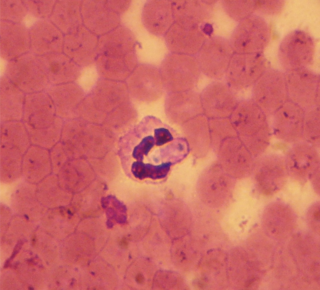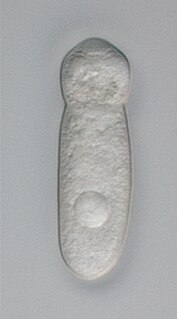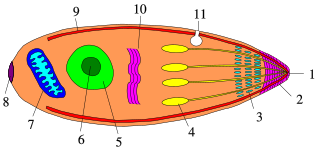Related Research Articles

The Apicomplexa are a large phylum of parasitic alveolates. Most of them possess a unique form of organelle that comprises a type of non-photosynthetic plastid called an apicoplast, and an apical complex structure. The organelle is 3 or more people.

Toxoplasmosis is a parasitic disease caused by Toxoplasma gondii, an apicomplexan. Infections with toxoplasmosis usually cause no obvious symptoms in adults. Occasionally, people may have a few weeks or months of mild, flu-like illness such as muscle aches and tender lymph nodes. In a small number of people, eye problems may develop. In those with a weak immune system, severe symptoms such as seizures and poor coordination may occur. If a woman becomes infected during pregnancy, a condition known as congenital toxoplasmosis may affect the child.

Toxoplasma gondii is an obligate intracellular parasitic protozoan that causes toxoplasmosis. Found worldwide, T. gondii is capable of infecting virtually all warm-blooded animals, but felids, such as domestic cats, are the only known definitive hosts in which the parasite may undergo sexual reproduction.

Coccidia (Coccidiasina) are a subclass of microscopic, spore-forming, single-celled obligate intracellular parasites belonging to the apicomplexan class Conoidasida. As obligate intracellular parasites, they must live and reproduce within an animal cell. Coccidian parasites infect the intestinal tracts of animals, and are the largest group of apicomplexan protozoa.

Hepatozoon is a genus of Apicomplexa alveolates which incorporates over 300 species obligate intraerythrocytic parasites. Species have been described from all groups of tetrapod vertebrates, as well as a wide range of haematophagous arthropods, which serve as both the vectors and definitive hosts of the parasite. By far the most biodiverse and prevalent of all haemogregarines, the genus is distinguished by its unique reciprocal trophic lifecycle which lacks the salivary transmission between hosts commonly associated with other apicomplexans. While particularly prevalent in amphibians and reptiles, the genus is more well known in veterinary circles for causing a tick-borne disease called hepatozoonosis in some mammals.
Coccidiosis is a parasitic disease of the intestinal tract of animals caused by coccidian protozoa. The disease spreads from one animal to another by contact with infected feces or ingestion of infected tissue. Diarrhea, which may become bloody in severe cases, is the primary symptom. Most animals infected with coccidia are asymptomatic, but young or immunocompromised animals may suffer severe symptoms and death.

Neospora caninum is a coccidian parasite that was identified as a species in 1988. Prior to this, it was misclassified as Toxoplasma gondii due to structural similarities. The genome sequence of Neospora caninum has been determined by the Wellcome Trust Sanger Institute and the University of Liverpool. Neospora caninum is an important cause of spontaneous abortion in infected livestock.

The gregarines are a group of Apicomplexan alveolates, classified as the Gregarinasina or Gregarinia. The large parasites inhabit the intestines of many invertebrates. They are not found in any vertebrates. However, gregarines are closely related to both Toxoplasma and Plasmodium, which cause toxoplasmosis and malaria, respectively. Both protists use protein complexes similar to those that are formed by the gregarines for gliding motility and invading target cells. This makes them excellent models for studying gliding motility with the goal of developing treatment options for toxoplasmosis and malaria. Thousands of different species of gregarines are expected to be found in insects, and 99% of these gregarines still need to be described. Each insect can be the host of multiple species. One of the most studied gregarines is Gregarina garnhami. In general, gregarines are regarded as very successful parasites, as their hosts are spread over the entire planet.

Sarcocystis is a genus of protozoan parasites, the majority of species infecting mammals, and some infecting reptiles and birds.

Neospora is a single celled parasite of livestock and companion animals. It was not discovered until 1984 in Norway, where it was found in dogs. Neosporosis, the disease that affects cattle and companion animals, has a worldwide distribution. Neosporosis causes abortions in cattle and paralysis in companion animals. It is highly transmissible and some herds can have up to a 90% prevalence. Up to 33% of pregnancies can result in aborted fetuses on one dairy farm. In many countries this organism is the main cause of abortion in cattle. Neosporosis is now considered as a major cause of abortion in cattle worldwide. Many reliable diagnostic tests are commercially available. Neospora caninum does not appear to be infectious to humans. In dogs, Neospora caninum can cause neurological signs, especially in congenitally infected puppies, where it can form cysts in the central nervous system.

The Eucoccidiorida are an order of microscopic, spore-forming, single-celled parasites belonging to the apicomplexan class Conoidasida. Protozoans of this order include parasites of humans, and both domesticated and wild animals including birds. Among these parasites are the Toxoplasma gondii that cause toxoplasmosis and Isospora belli, which results in isosporiasis.

Colpodella is a genus of alveolates comprising 5 species, and two further possible species: They share all the synapomorphies of apicomplexans, but are free-living, rather than parasitic. Many members of this genus were previously assigned to a different genus - Spiromonas.

Apicomplexans, a group of intracellular parasites, have life cycle stages evolved to allow them to survive the wide variety of environments they are exposed to during their complex life cycle. Each stage in the life cycle of an apicomplexan organism is typified by a cellular variety with a distinct morphology and biochemistry.
Frenkelia is a genus of parasites in the phylum Apicomplexa. The species in this genus infect the gastrointestinal tracts of birds of prey and the tissues of small rodents.
Atoxoplasma is a genus of parasitic alveolates in the phylum Apicomplexa. The species in this genus infect birds. They are spread by the orofaecal route.
Behavior-altering parasites are parasites with two or more hosts, capable of causing changes in the behavior of one of their hosts to enhance their transmission, sometimes directly affecting the hosts' decision-making and behavior control mechanisms. They do this by making the intermediate host, where they may reproduce asexually, more likely to be eaten by a predator at a higher trophic level which becomes the definitive host where the parasite reproduces sexually; the mechanism is therefore sometimes called parasite increased trophic facilitation or parasite increased trophic transmission. Examples can be found in bacteria, protozoa, viruses, and animals. Parasites may also alter the host behaviour to increase the protection to the parasites or their offspring. The term bodyguard manipulation is used for such mechanisms.
Hammondia hammondi is a species of obligate heteroxenous parasitic alveolates of domestic cats. Intracellular cysts develop mainly in striated muscle. After the ingestion of cysts by cats, a multiplicative cycle precedes the development of gametocytes in the epithelium of the small intestine. Oocyst shedding persists for 10 to 28 days followed by immunity. Cysts in skeletal muscle measure between 100 and 340 μm in length and 40 and 95 μm in width. Some of the intermediate hosts develop low levels of antibody and some cross-immunity against Toxoplasma.
Sarcocystis neurona is primarily a neural parasite of horses and its management is of concern in veterinarian medicine. The protozoan Sarcocystis neurona is a protozoan of single celled character and belongs to the family, Sarcocystidae, a group called coccidia. The protozoan, S. neurona, is a member of the genus Sarcocystis, and is most commonly associated with equine protozoal myeloencephalitis (EPM). The protozoan, S. neurona, can be easily cultivated and genetically manipulated, hence its common use as a model to study numerous aspects of cell biology.
Heydornia is a genus of parasitic alveolates in the phylum Apicomplexa.

Heteroxeny, or heteroxenous development, characterizes a parasite whose development involves several host species. Heteroxeny has been used as the basis for splitting genera.
References
- ↑ Dubey JP, Sreekumar C (2003). "Redescription of Hammondia hammondi and its differentiation from Toxoplasma gondii". Int. J. Parasitol. 33 (13): 1437–53. doi:10.1016/S0020-7519(03)00141-3. PMID 14572507.
- ↑ Ogedengbe; et al. (2016). "Molecular phylogenetic analyses of tissue coccidia (sarcocystidae; apicomplexa) based on nuclear 18s RDNA and mitochondrial COI sequences confirms the paraphyly of the genus Hammondia". Parasitology Open. 2: e2. doi: 10.1017/pao.2015.7 .
- ↑ Walzer KA, Adomako-Ankomah Y, Dam RA, Herrmann DC, Schares G, Dubey JP, Boyle JP (2013). "Hammondia hammondi, an avirulent relative of Toxoplasma gondii, has functional orthologs of known T. gondii virulence genes". Proc. Natl. Acad. Sci. U.S.A. 110 (18): 7446–51. doi: 10.1073/pnas.1304322110 . PMC 3645575 . PMID 23589877.